by Leslie Cox; Saturday, September 8, 2012
 Many of us have likely encountered a few tomatoes that are turning black or an ugly brown colour and shrivelling at the bottom, or blossom end, of the fruit.
Many of us have likely encountered a few tomatoes that are turning black or an ugly brown colour and shrivelling at the bottom, or blossom end, of the fruit.
Blossom end rot is usually associated with tomatoes but other fruits such as squash and cucumbers can get it too.
The cause in all cases is a lack of calcium in the developing fruit so either there is not enough calcium in the soil or the plant is not able to absorb it.
Calcium is very necessary for the development of a strong cell structure. A deficiency of this mineral will result in weakened cellular walls that will begin to collapse as the fruit grows. This opens up the possibility for rot to set in, beginning at the blossom end…the starting point for developing fruits.
The only accurate way to determine if you have enough calcium in your soil is by having a sample analyzed by a lab. However, if you amended your vegetable bed with either ground calcitic limestone which contains calcium (Ca) or Dolomitic lime which contains both calcium and magnesium (Mg), then the soil is not at issue in this instance.
For plants to absorb calcium…or any other nutrients for that matter…from the soil, they must have adequate water. It is the only way nutrients can travel up into the plant’s vascular system.
The right amount of water delivered on a regular basis is very important for the growth of your vegetables. It is especially important in a greenhouse situation since the plants are not exposed to rainfall. Uneven watering results in nutrient deficiencies for any developing fruit at a very critical time.
One further problem could be soil acidity, or pH. If the soil is too acidic (low pH) the calcium and other nutrients are “locked” in the soil and become unavailable to the plants. A pH of between 6.5 and 7.0 is ideal for most plants, allowing them to access the necessary nutrients for growth.
Here in the Pacific Northwest region, our soil is on the acidic side. But again, if you added lime, which is alkaline (high pH), when you prepped your vegetable bed earlier in the season then you will have adjusted the soil acidity adequately. Provided you followed the recommended application amounts on the bag, of course.
If you have tomatoes, cucumbers or squashes with blossom end rot in your garden, don’t despair. There is hope. To rescue the rest of your fruit for this season, first remove all of the damaged fruit. Then scratch one cup (250 ml) of Dolomitic lime into the soil around each plant and water it in well. (Watering it in will dilute the calcium enough to avoid burning the plants.)
